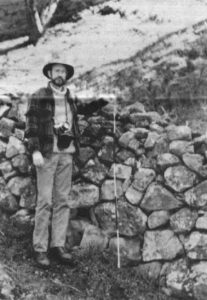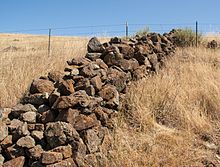 There is a wall that lots o people might have known about, or maybe few people know about, but while I’m sure I’ve seen parts of it in movies, I didn’t really know about it. The series of walls, known as the East Bay Walls or the Berkeley Mystery Walls. Of course that doesn’t really apply to one area, because the reality is that there are many of the crude walls throughout the hills surrounding the San Francisco Bay area. In some place the walls are as much as 3 feet tall, and 3 feet wide. The walls are very old and they were built without mortar. The walls run in sections, and they can be a few feet to over a mile long. Even more odd, is the fact that the rocks are a variety of sizes ranging from basketball-sized rocks, to large sandstone boulders weighing a ton or more. Parts of the walls seem to be just piles of rocks, but in other places it appears the walls were carefully constructed. No one knows the exact age of the walls, but they have an old appearance. Many of the formations have sunk far into the earth, and are often completely overgrown with different plants. The walls are not continuous, so they are not fences. They are not tall enough to have been used as defensive walls. The East Bay Regional Park District simply calls them “rock walls” and insists that they are not mysterious. Livestock, such as cattle, have grazed in the east and south Bay Area hills since the arrival of European
There is a wall that lots o people might have known about, or maybe few people know about, but while I’m sure I’ve seen parts of it in movies, I didn’t really know about it. The series of walls, known as the East Bay Walls or the Berkeley Mystery Walls. Of course that doesn’t really apply to one area, because the reality is that there are many of the crude walls throughout the hills surrounding the San Francisco Bay area. In some place the walls are as much as 3 feet tall, and 3 feet wide. The walls are very old and they were built without mortar. The walls run in sections, and they can be a few feet to over a mile long. Even more odd, is the fact that the rocks are a variety of sizes ranging from basketball-sized rocks, to large sandstone boulders weighing a ton or more. Parts of the walls seem to be just piles of rocks, but in other places it appears the walls were carefully constructed. No one knows the exact age of the walls, but they have an old appearance. Many of the formations have sunk far into the earth, and are often completely overgrown with different plants. The walls are not continuous, so they are not fences. They are not tall enough to have been used as defensive walls. The East Bay Regional Park District simply calls them “rock walls” and insists that they are not mysterious. Livestock, such as cattle, have grazed in the east and south Bay Area hills since the arrival of European  settlers. Clearing land of scattered rocks would have eased the ability to move livestock. Placing the rocks into walls would have helped to guide the movement of the animals or to help corral them. That makes sense, but some of those rocks were very heavy. So how did they do that.
settlers. Clearing land of scattered rocks would have eased the ability to move livestock. Placing the rocks into walls would have helped to guide the movement of the animals or to help corral them. That makes sense, but some of those rocks were very heavy. So how did they do that.
There is no written documentation to identify when they were built, by whom, or why. So, some people consider them mysterious. It has been suggested that the Ohlone Indians might have been the builders, but in reality, they were hunter-gatherers, and didn’t build permanent structures. Some specialists have mentioned that the walls look similar to structures found in rural Massachusetts, Vermont, and Maine, but they are different in that those walls were built around farms by the early setters, and these don’t have the same kinds of layouts. In 1904, UC-Berkeley Professor John Fryer suggested that the walls were made by Mongolian Chinese who traveled to California before the Europeans. Unfortunately, there is little evidence for this or for pre-Columbian Chinese influence in America. Forensic geologist Scott Wolter has theorized that the wall is only two to three hundred years old, suggested by the thick weathering rind on the limestone rock he was authorized to sample. Recent testing of lichen on the rocks suggests that they were probably built between 1850 and 1880, the early American era in California. Settlers might have built the walls using Chinese, Mexican, or Native American laborers, although specifically who built them has not been determined.
One of the many old stone walls that appear around the San Francisco Bay area is in the foothills of eastern  Santa Clara County. The stone walls are accessible in several area parks, including Ed R. Levin County Park in Santa Clara County and Mission Peak Regional Preserve in Alameda County, as well as many other parks. As of 2016, archaeologist Jeffrey Fentress has been measuring and mapping the walls, hoping to eventually gain protection from development or other destruction. Additional stone walls with unclear origin or purpose occur in other places near the San Francisco Bay, and researchers continue to discover more information about the walls. Whether these walls had a purpose at one time or not, they are certainly strange to those who try to look into them these days.
Santa Clara County. The stone walls are accessible in several area parks, including Ed R. Levin County Park in Santa Clara County and Mission Peak Regional Preserve in Alameda County, as well as many other parks. As of 2016, archaeologist Jeffrey Fentress has been measuring and mapping the walls, hoping to eventually gain protection from development or other destruction. Additional stone walls with unclear origin or purpose occur in other places near the San Francisco Bay, and researchers continue to discover more information about the walls. Whether these walls had a purpose at one time or not, they are certainly strange to those who try to look into them these days.


Leave a Reply